Spatiotemporal Dynamics of Urban and Rural Settlements in Tanzania (1975–2020): Drivers, Patterns, and Regional Disparities
Abstract
1. Introduction
1.1. Background
1.2. Literature Review
1.3. Study Area Selection
1.4. Research Objectives
2. Materials and Methods
2.1. Overview of the Study Area
2.2. Data Source and Processing
2.3. Research Method
2.3.1. Land Use Transfer Matrix
2.3.2. Hotspot Analysis
2.3.3. Standard Deviation Ellipse Analysis
2.3.4. Geographic Detector
3. Results
3.1. Overall Situation of Settlement Changes
3.1.1. Changes in Settlement Area
3.1.2. Transformation of Settlement Types
3.2. Distribution and Spatiotemporal Evolution of Settlements
3.2.1. Overall Distribution of Settlements
3.2.2. Analysis of Coldspots and Hotspots in Relation to Settlement Changes
3.2.3. Distribution Direction and Center of Settlements
3.3. Causes of Spatial Differentiation in Tanzanian Settlements
4. Discussion
4.1. Convergence with and Departure from Global Urbanization Theories
4.2. Policy Implications and Regional Development Dynamics
4.3. Urban–Rural Interdependencies and Sustainability Challenges
4.4. Relevance for China–Africa Cooperation
5. Conclusions
Author Contributions
Funding
Data Availability Statement
Conflicts of Interest
Abbreviations
| GIS | Geographic Information System |
| GHSL | Global Human Settlement Layer |
References
- UN. World Population Prospects—Summary of Results; United Nations: New York, NY, USA, 2022; Available online: https://www.un.org/development/desa/pd/sites/www.un.org.development.desa.pd/files/wpp2022_summary_of_results.pdf (accessed on 12 February 2024).
- Sumari, N.S.; Cobbinah, P.B.; Ujoh, F.; Xu, G. On the Absurdity of Rapid Urbanization: Spatio-Temporal Analysis of Land-Use Changes in Morogoro, Tanzania. Cities 2020, 107, 102876. [Google Scholar] [CrossRef]
- Shi, C.; Zhu, X.; Wu, H.; Li, Z. Urbanization Impact on Regional Sustainable Development: Through the Lens of Urban-Rural Resilience. Int. J. Environ. Res. Public Health 2022, 19, 15407. [Google Scholar] [CrossRef] [PubMed]
- Profiroiu, C.M.; Bodislav, D.A.; Burlacu, S.; Radulescu, C.V. Challenges of Sustainable Urban Development in the Context of Population Growth. Eur. J. Sustain. Dev. 2020, 9, 51–57. [Google Scholar] [CrossRef]
- Gibas, P.; Majorek, A. Analysis of Land-Use Change between 2012–2018 in Europe in Terms of Sustainable Development. Land 2020, 9, 46. [Google Scholar] [CrossRef]
- Baqa, M.F.; Lu, L.; Chen, F.; Nawaz-ul-Huda, S.; Pan, L.; Tariq, A.; Qureshi, S.; Li, B.; Li, Q. Characterizing Spatiotemporal Variations in the Urban Thermal Environment Related to Land Cover Changes in Karachi, Pakistan, from 2000 to 2020. Remote Sens. 2022, 14, 2164. [Google Scholar] [CrossRef]
- Gutierrez, E.; Moral-Benito, E.; Oto-Peralias, D.; Ramos, R. The Spatial Distribution of Population in Spain: An Anomaly in European Perspective. J. Reg. Sci. 2023, 63, 728–750. [Google Scholar] [CrossRef]
- Liao, B.; Wang, Z.; He, J.; Wu, J.; Su, J. The Driving Mechanisms for Human Settlement and Ecological Environment in the Upper Minjiang Watershed, China. Front. Environ. Sci. 2023, 11, 1097801. [Google Scholar] [CrossRef]
- Sheng, S.; Lian, H. The Spatial Pattern Evolution of Rural Settlements and Multi-Scenario Simulations since the Initiation of the Reform and Opening up Policy in China. Land 2023, 12, 1763. [Google Scholar] [CrossRef]
- Togiti, D.; Naik, G.; Bagadi, R.C. Investigation on Built-up, Population, and Road Network Density Dynamics Using GIS, Regression, and Causation Analysis: A Case Study of Hyderabad City, India. J. Urban Plann. Dev. 2023, 149, 04023020. [Google Scholar] [CrossRef]
- Strano, E.; Simini, F.; De Nadai, M.; Esch, T.; Marconcini, M. The Agglomeration and Dispersion Dichotomy of Human Settlements on Earth. Sci. Rep. 2021, 11, 23289. [Google Scholar] [CrossRef]
- Hu, Q.; Wang, C. Quality Evaluation and Division of Regional Types of Rural Human Settlements in China. Habitat Int. 2020, 105, 102278. [Google Scholar] [CrossRef]
- Corbane, C.; Syrris, V.; Sabo, F.; Politis, P.; Melchiorri, M.; Pesaresi, M.; Soille, P.; Kemper, T. Convolutional Neural Networks for Global Human Settlements Mapping from Sentinel-2 Satellite Imagery. Neural Comput. Appl. 2021, 33, 6697–6720. [Google Scholar] [CrossRef]
- Tan, B.; Wang, H.; Wang, X.; Yi, S.; Zhou, J.; Ma, C.; Dai, X. The Study of Early Human Settlement Preference and Settlement Prediction in Xinjiang, China. Sci. Rep. 2022, 12, 5072. [Google Scholar] [CrossRef] [PubMed]
- Bian, J.; Chen, W.; Zeng, J. Spatial Distribution Characteristics and Influencing Factors of Traditional Villages in China. Int. J. Environ. Res. Public Health 2022, 19, 4627. [Google Scholar] [CrossRef]
- Cong, X.; Li, X.; Gong, Y. Spatiotemporal Evolution and Driving Forces of Sustainable Development of Urban Human Settlements in China for SDGs. Land 2021, 10, 993. [Google Scholar] [CrossRef]
- Sun, D.; Hong, B.; Ren, P. Spatiotemporal Evolution and Driving Factors of the Rural Settlements in the Mountain-Plain Transitional Zone. Int. J. Agric. Biol. Eng. 2022, 15, 149–155. [Google Scholar] [CrossRef]
- Wang, J.; Zhang, Y. Analysis on the Evolution of Rural Settlement Pattern and Its Influencing Factors in China from 1995 to 2015. Land 2021, 10, 1137. [Google Scholar] [CrossRef]
- Qin, Y.; Wang, L.; Yu, M.; Meng, X.; Fan, Y.; Huang, Z.; Luo, E.; Pijanowski, B. The Spatio-Temporal Evolution and Transformation Mode of Human Settlement Quality from the Perspective of “Production-Living-Ecological” Spaces—A Case Study of Jilin Province. Habitat Int. 2024, 145, 103021. [Google Scholar] [CrossRef]
- Ran, D.; Hu, Q.; Zhang, Z. Spatial-Temporal Evolution, Impact Mechanisms, and Reclamation Potential of Rural Human Settlements in China. Land 2024, 13, 430. [Google Scholar] [CrossRef]
- Zhong, Q.; Dong, T. Exploring the Spatiotemporal Trends and Influencing Factors of Human Settlement Suitability in Hunan Province Traditional Villages. Sci. Rep. 2024, 14, 25319. [Google Scholar] [CrossRef]
- Xie, T.; Liu, X.; Nie, P. Study on Spatial-Temporal Patterns and Factors Influencing Human Settlement Quality in Beijing. Sustainability 2022, 14, 3752. [Google Scholar] [CrossRef]
- Song, R.; Li, X.; Hou, X. Spatial Network Structure and Driving Factors of Human Settlements in Three Northeastern Provinces of China. Front. Ecol. Evol. 2023, 11, 1206808. [Google Scholar] [CrossRef]
- Song, R.; Li, X. Urban Human Settlement Vulnerability Evolution and Mechanisms: The Case of Anhui Province, China. Land 2023, 12, 994. [Google Scholar] [CrossRef]
- Chen, L.; Zhong, Q.; Li, Z. Analysis of Spatial Characteristics and Influence Mechanism of Human Settlement Suitability in Traditional Villages Based on Multi-Scale Geographically Weighted Regression Model: A Case Study of Hunan Province. Ecol. Indic. 2023, 154, 110828. [Google Scholar] [CrossRef]
- Guo, Z.; Chen, S.S.; Kattel, G.R.; Mkumbo, A.C.; Xiong, C.; Gao, Q.; Shen, Q. Scenario Analysis of Phosphorus Flow in Food Production and Consumption System in the Mwanza Region, Tanzania. Sci. Total Environ. 2023, 879, 162991. [Google Scholar] [CrossRef] [PubMed]
- Zhang, J.; Chen, S.S.; Gao, Q.; Shen, Q.; Kimirei, I.A.; Mapunda, D.W. Morphological Characteristics of Informal Settlements and Strategic Suggestions for Urban Sustainable Development in Tanzania: Dar Es Salaam, Mwanza, and Kigoma. Sustainability 2020, 12, 3807. [Google Scholar] [CrossRef]
- Pesaresi, M.; Schiavina, M.; Politis, P.; Freire, S.; Krasnodebska, K.; Uhl, J.H.; Carioli, A.; Corbane, C.; Dijkstra, L.; Florio, P.; et al. Advances on the Global Human Settlement Layer by Joint Assessment of Earth Observation and Population Survey Data. Int. J. Digital Earth 2024, 17, 2390454. [Google Scholar] [CrossRef]
- Zheng, Z.; Fu, B.; Feng, X. GIS-Based Analysis for Hotspot Identification of Tradeoff between Ecosystem Services: A Case Study in Yanhe Basin, China. Chin. Geogr. Sci. 2016, 26, 466–477. [Google Scholar] [CrossRef]
- Zhang, Y.; Jiang, P.; Cui, L.; Yang, Y.; Ma, Z.; Wang, Y.; Miao, D. Study on the Spatial Variation of China’s Territorial Ecological Space Based on the Standard Deviation Ellipse. Front. Environ. Sci. 2022, 10, 982734. [Google Scholar] [CrossRef]
- Zhao, R.; Zhan, L.; Yao, M.; Yang, L. A Geographically Weighted Regression Model Augmented by Geodetector Analysis and Principal Component Analysis for the Spatial Distribution of PM2.5. Sustain. Cities Soc. 2020, 56, 102106. [Google Scholar] [CrossRef]
- Jiang, S.; Zhang, Z.; Ren, H.; Wei, G.; Xu, M.; Liu, B. Spatiotemporal Characteristics of Urban Land Expansion and Population Growth in Africa from 2001 to 2019: Evidence from Population Density Data. ISPRS Int. J. Geo-Inf. 2021, 10, 584. [Google Scholar] [CrossRef]
- Yussif, K.; Dompreh, E.B.; Gasparatos, A. Sustainability of Urban Expansion in Africa: A Systematic Literature Review Using the Drivers-Pressures-State-Impact-Responses (DPSIR) Framework. Sustain. Sci. 2023, 18, 1459–1479. [Google Scholar] [CrossRef]
- Korah, A.; Koch, J.A.M.; Wimberly, M.C. Understanding Urban Growth Modeling in Africa: Dynamics, Drivers, and Challenges. Cities 2024, 146, 104734. [Google Scholar] [CrossRef]
- Abu Abdulai, I.; Kuusaana, E.D.; Ahmed, A. Toward Sustainable Urbanization: Understanding the Dynamics of Urban Sprawl and Food (in)Security of Indigenous Households in Peri-Urban Wa, Ghana. J. Urban Aff. 2025, 47, 1371–1396. [Google Scholar] [CrossRef]
- Taiwo, O.J. Modelling the Spatiotemporal Patterns of Urban Sprawl in Ibadan Metropolis Between 1984 and 2013 in Nigeria. Model. Earth Syst. Environ. 2022, 8, 121–140. [Google Scholar] [CrossRef]
- Follmann, A. Geographies of Peri-Urbanization in the Global South. Geogr. Compass 2022, 16, e12650. [Google Scholar] [CrossRef]
- Ashiagbor, G.; Amoako, C.; Asabere, S.B.; Quaye-Ballard, J.A. Landscape Transformations in Rapidly Developing Peri-Urban Areas of Accra, Ghana: Results of 30 Years. Open Geosci. 2019, 11, 172–182. [Google Scholar] [CrossRef]
- Henderson, J.V.; Kriticos, S. The Development of the African System of Cities. Annu. Rev. Econ. 2018, 10, 287–314. [Google Scholar] [CrossRef]
- Wolff, E.; Grippa, T.; Forget, Y.; Georganos, S.; Vanhuysse, S.; Shimoni, M.; Linard, C. Diversity of Urban Growth Patterns in Sub-Saharan Africa in the 1960–2010 Period. Afr. Geogr. Rev. 2020, 39, 45–57. [Google Scholar] [CrossRef]
- Bechir, R.; Ounalli, N.; Jaouad, M.; Sghaier, M. Regional Disparities and Local Development in Southern Tunisia. New Medit 2020, 19, 35–50. [Google Scholar] [CrossRef]
- Kerkouch, A.; Bensbahou, A.; Seyagh, I.; Agouram, J. Dynamic Analysis of Income Disparities in Africa: Spatial Markov Chains Approach. Sci. Afr. 2024, 24, e02236. [Google Scholar] [CrossRef]
- Brand, A.D.W.; Drewes, J.E.; Campbell, M. Differentiated Outlook to Portray Secondary Cities in South Africa. AIMS Geosci. 2021, 7, 457–477. [Google Scholar] [CrossRef]
- Sondou, T.; Anoumou, K.R.; Aholou, C.C.; Chenal, J.; Colombo, V.P. Urban Growth and Land Artificialization in Secondary African Cities: A Spatiotemporal Analysis of Ho (Ghana) and Kpalimé (Togo). Urban Sci. 2024, 8, 207. [Google Scholar] [CrossRef]
- Jedwab, R.; Christiaensen, L.; Gindelsky, M. Demography, Urbanization and Development: Rural Push, Urban Pull and … Urban Push? J. Urban Econ. 2017, 98, 6–16. [Google Scholar] [CrossRef]
- Brown, D. Towards a Comparative Research Agenda on in Situ Urbanisation and Rural Governance Transformation. Int. Dev. Plan. Rev. 2021, 43, 289–320. [Google Scholar] [CrossRef]
- Jiang, S.; Ren, H.; Zhang, Z. Monitoring and Assessing the Growth Law of Urban Land Using Multi-Source Data: A Case Study of Five East African Countries. Land Use Policy 2025, 153, 107530. [Google Scholar] [CrossRef]
- Yuan, Y.; Chen, S.S.; Miao, Y. Unmanaged Urban Growth in Dar Es Salaam: The Spatiotemporal Pattern and Influencing Factors. Sustainability 2023, 15, 575. [Google Scholar] [CrossRef]
- Enoguanbhor, E.C.; Gollnow, F.; Walker, B.B.; Nielsen, J.O.; Lakes, T. Key Challenges for Land Use Planning and Its Environmental Assessments in the Abuja City-Region, Nigeria. Land 2021, 10, 443. [Google Scholar] [CrossRef]
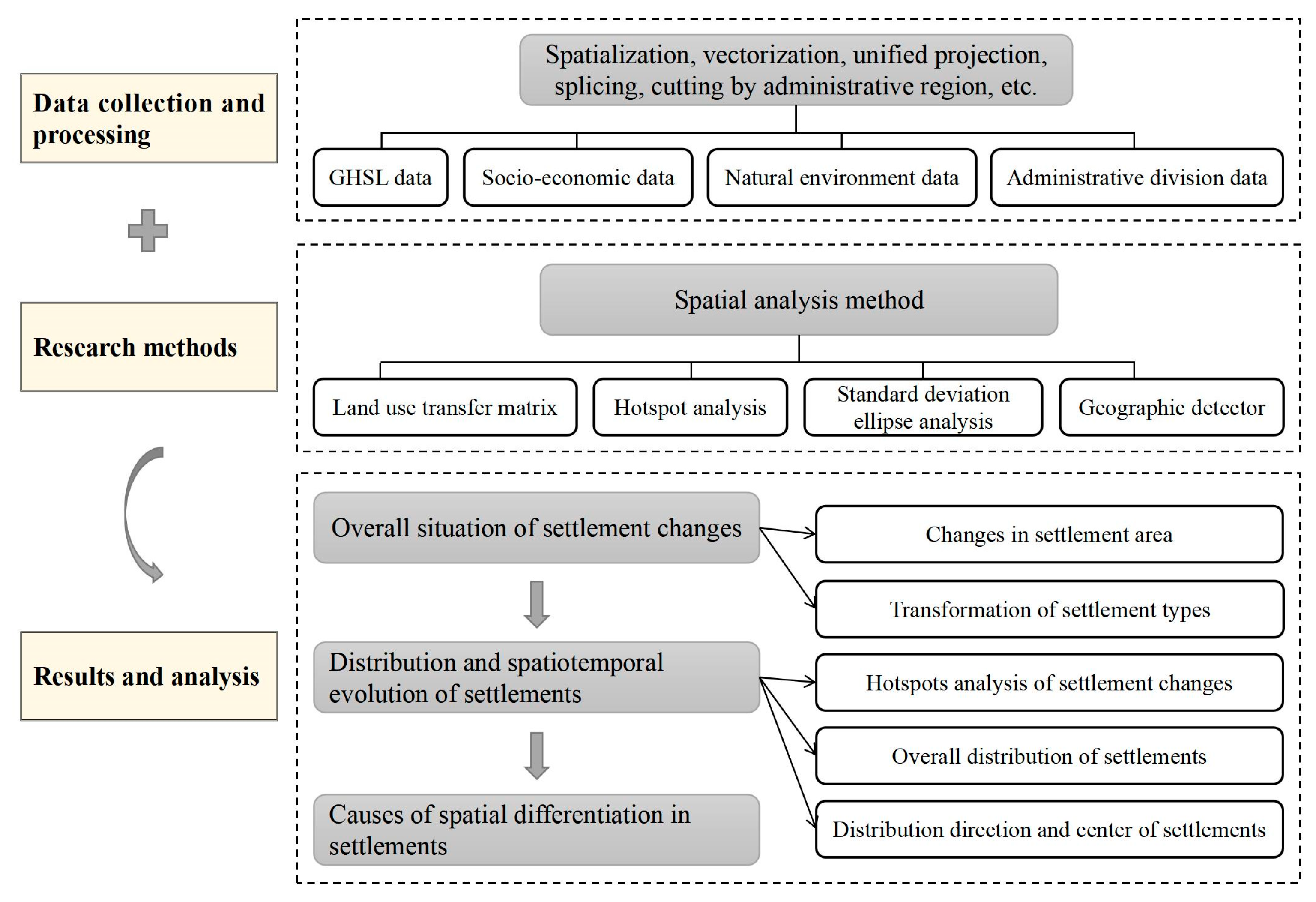
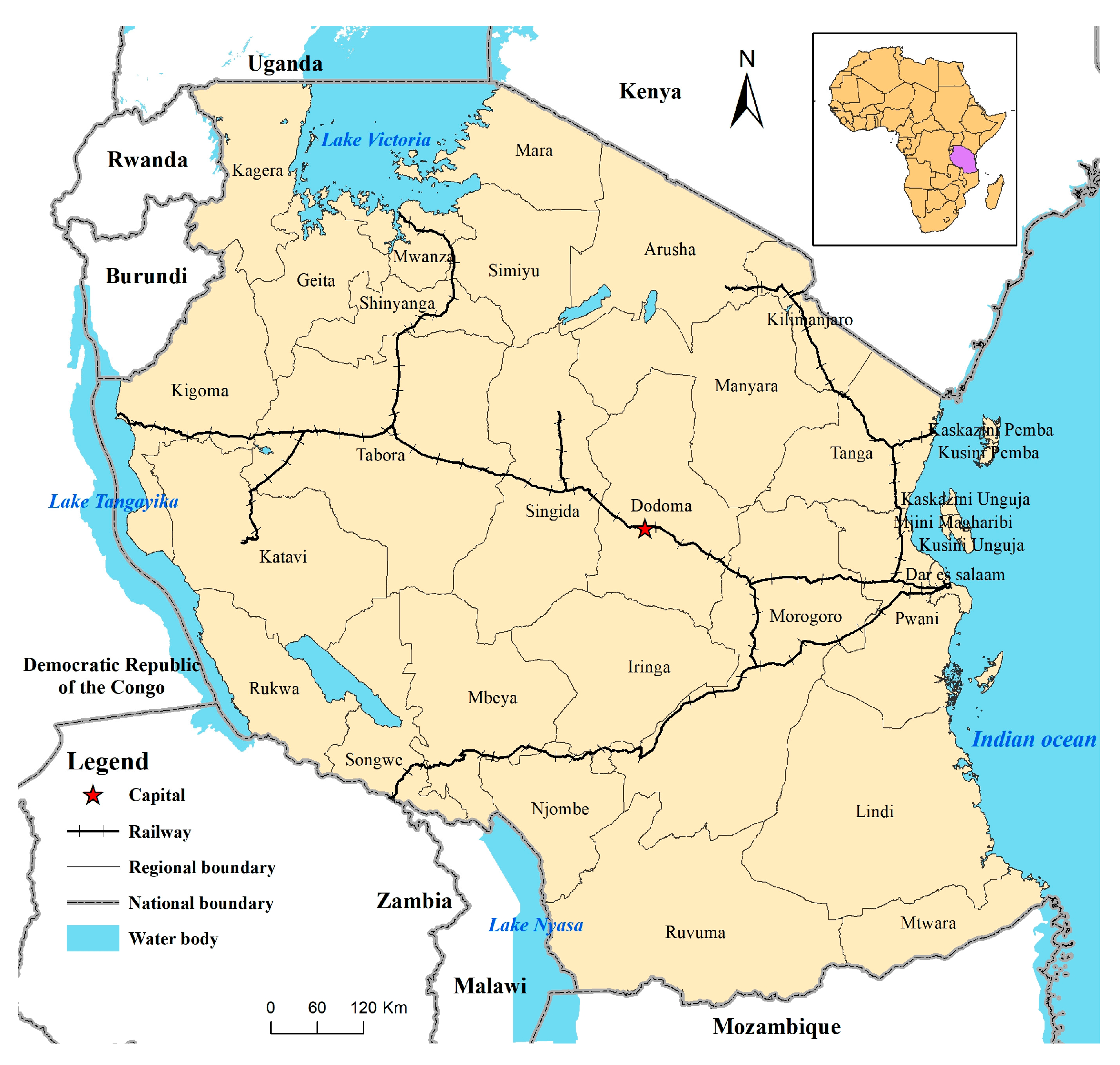
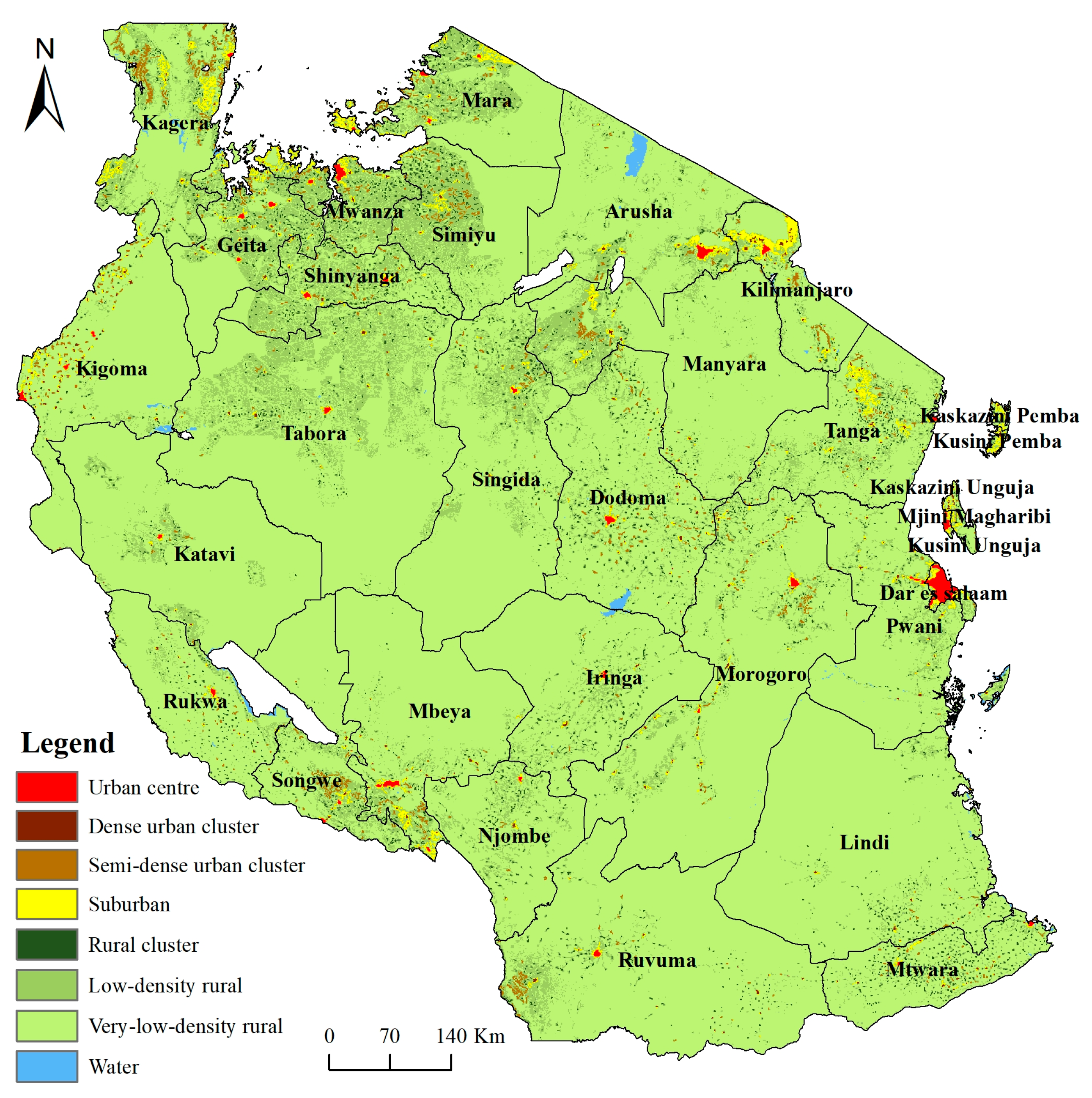
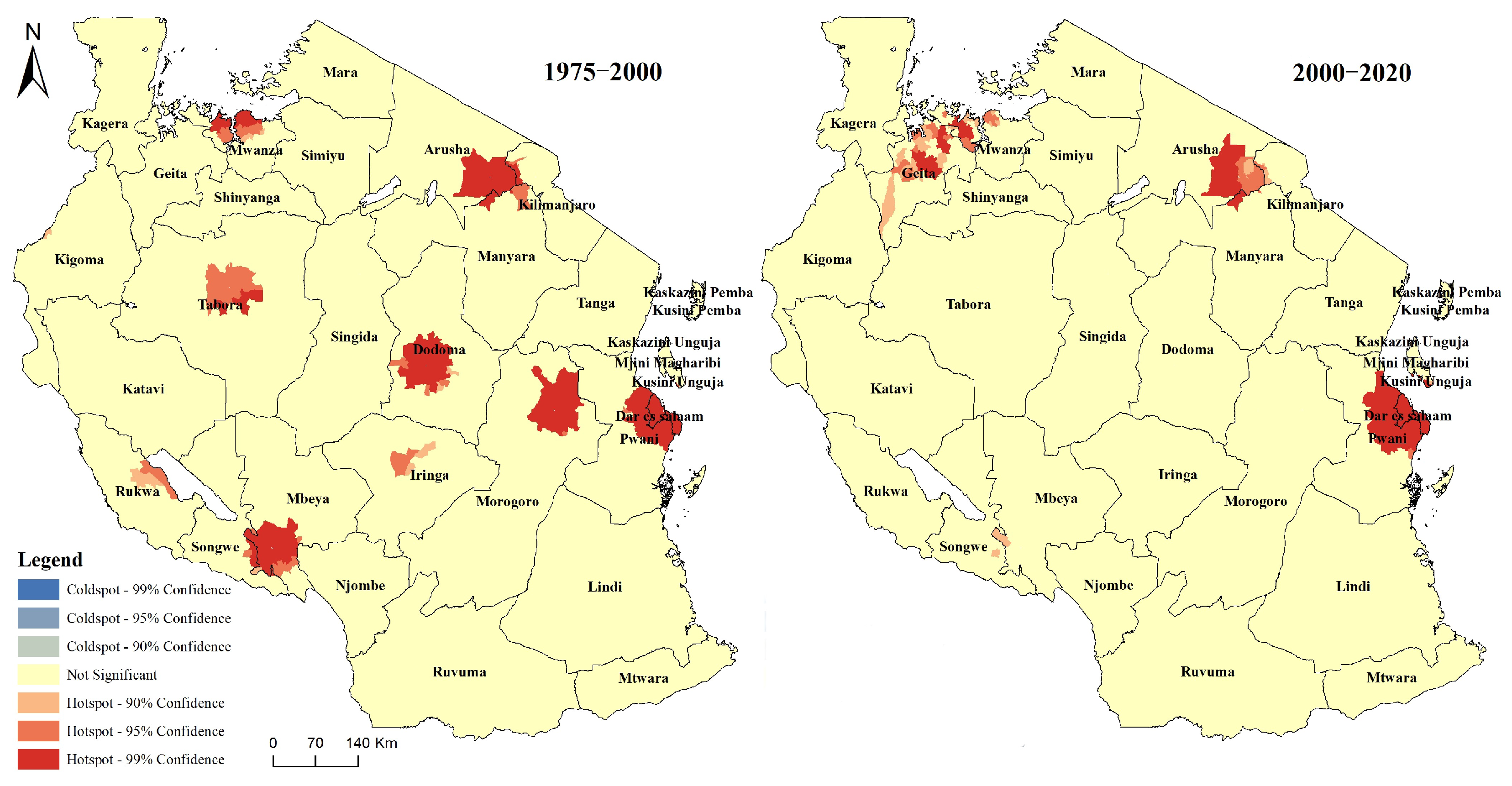
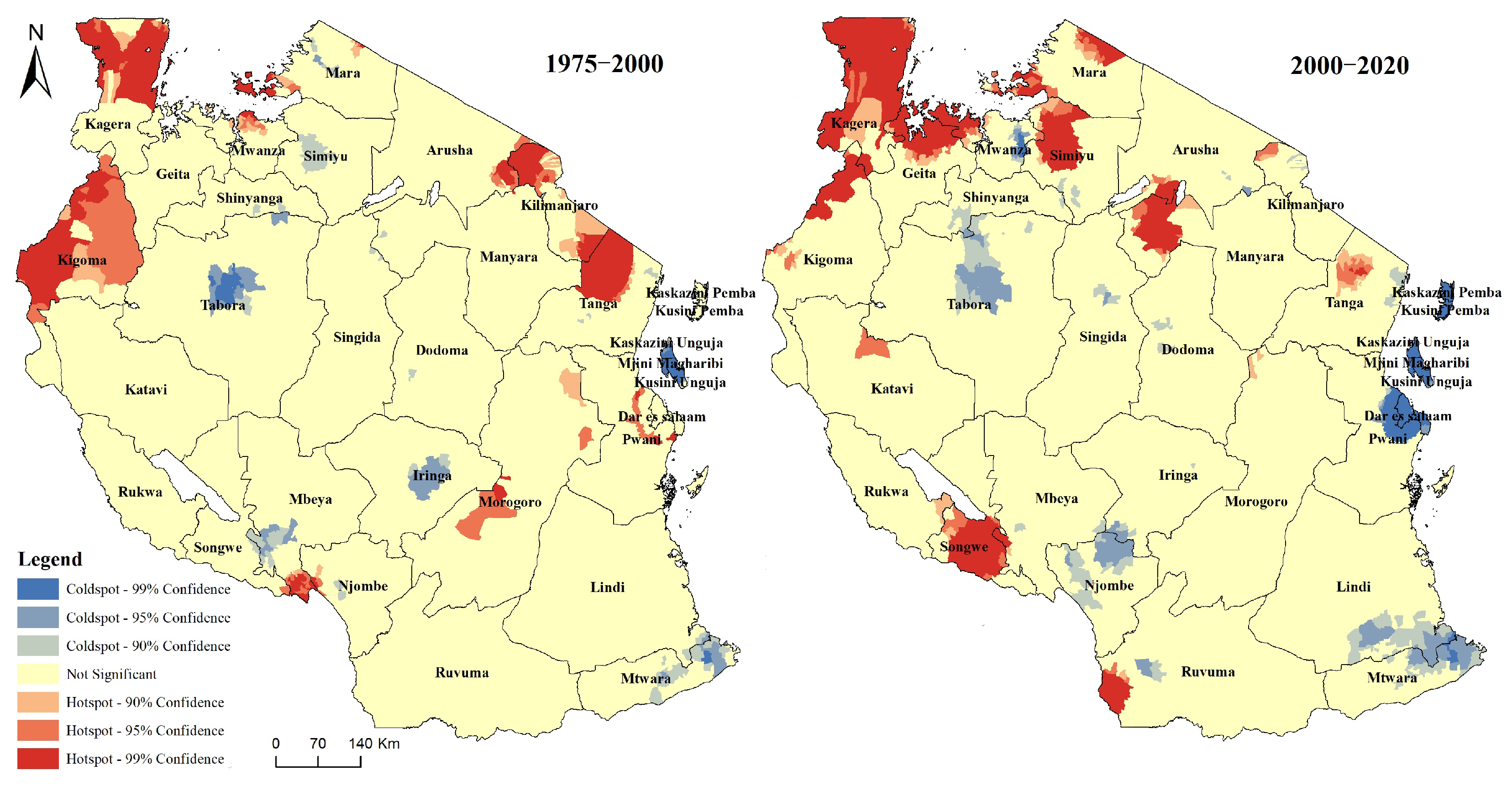
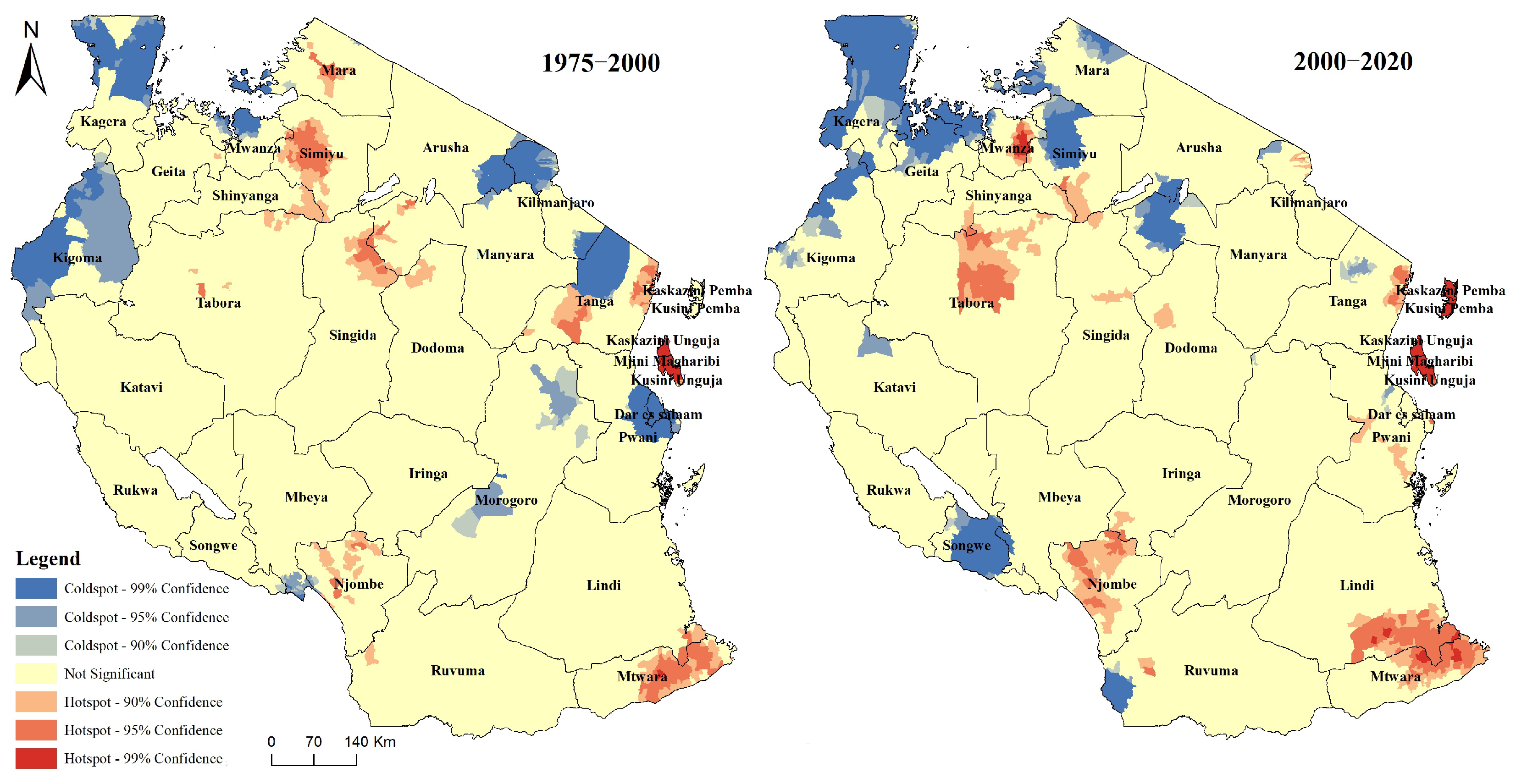

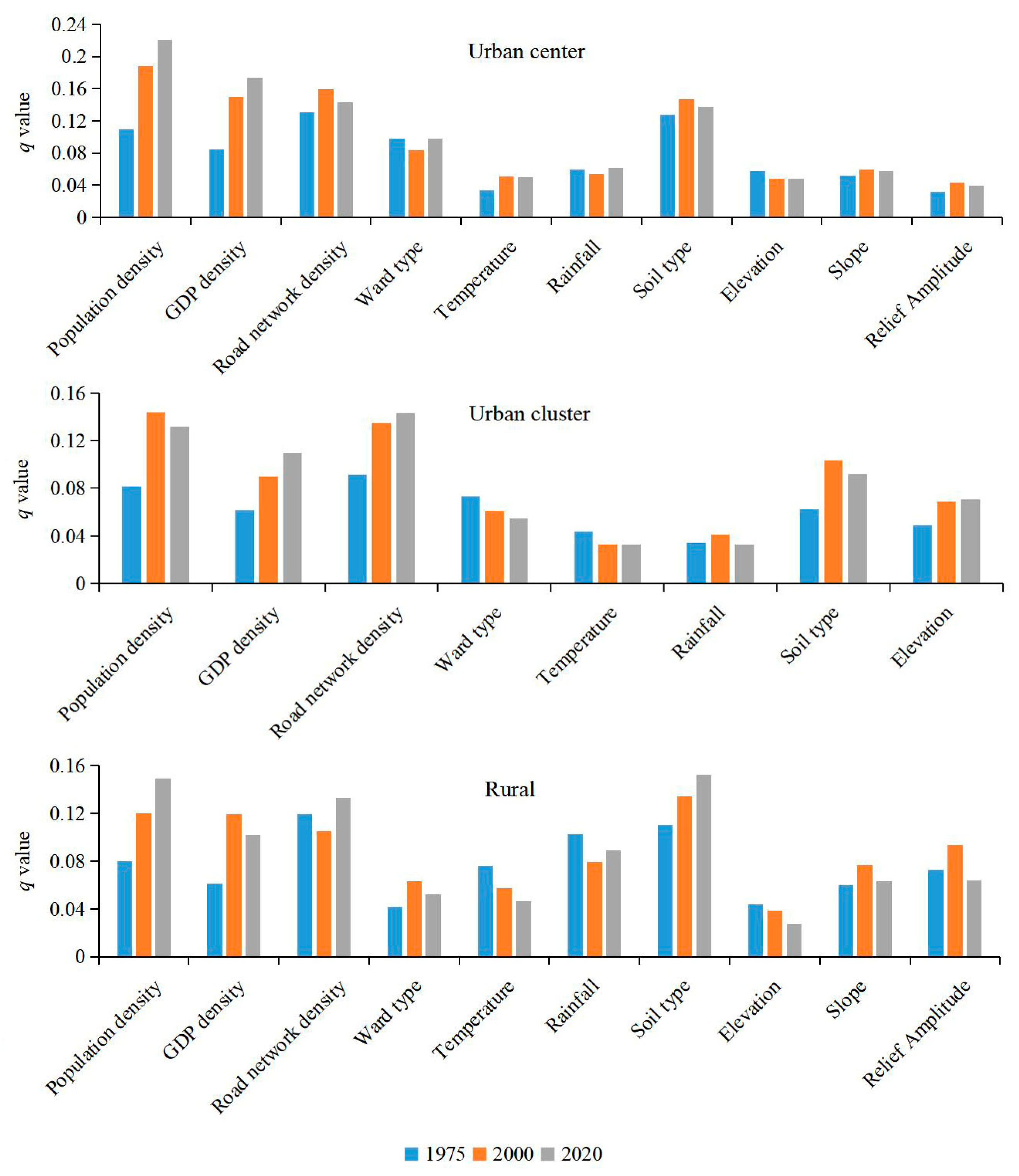
| Data Type | Data Name | Data Source | Time Periods (Year) |
| Settlement data | GHS Settlement Model | https://ghsl.jrc.ec.europa.eu/ (accessed on 5 December 2024) | 1975–2020 |
| Socio-economic data | Population | https://ghsl.jrc.ec.europa.eu/ (accessed on 5 December 2024) | 1975–2020 |
| GDP | https://www.nature.com/articles/s41597-022-01322-5 (accessed on 10 December 2024) | 1992–2019 | |
| Road network | https://download.geofabrik.de/index.html (accessed on 15 September 2024) | 2015–2020 | |
| Natural environment data | Temperature | https://climateknowledgeportal.worldbank.org/ (accessed on 11 December 2024) | 1991–2020 |
| Rainfall | https://climateknowledgeportal.worldbank.org/ (accessed on 11 December 2024) | 1991–2020 | |
| Soil type | https://www.ilri.org/ (accessed on 15 September 2024) | 2006 | |
| Elevation | https://earthexplorer.usgs.gov/ (accessed on 15 September 2024) | 2014 | |
| Administrative divisions data | Administrative divisions | http://www.nbs.go.tz (accessed on 8 January 2025) | 2025 |
| Primary Settlements | 1975 | 1990 | 2000 | 2015 | 2020 | Secondary Settlements | 1975 | 1990 | 2000 | 2015 | 2020 |
|---|---|---|---|---|---|---|---|---|---|---|---|
| Urban center | 340 | 914 | 1279 | 2062 | 2351 | Urban center | 340 | 914 | 1279 | 2062 | 2351 |
| Urban cluster | 2799 | 5563 | 8438 | 14,890 | 19,620 | Dense urban cluster | 517 | 811 | 1120 | 1772 | 1970 |
| Semi-dense urban cluster | 992 | 1652 | 3096 | 5327 | 7150 | ||||||
| Suburban | 1290 | 3100 | 4222 | 7791 | 10,500 | ||||||
| Rural | 887,146 | 883,808 | 880,568 | 873,333 | 868,314 | Rural cluster | 4215 | 7349 | 9082 | 12,741 | 13,953 |
| Low-density rural | 51,669 | 68,626 | 79,398 | 109,322 | 123,360 | ||||||
| Very-low-density rural | 828,158 | 804,777 | 789,050 | 748,293 | 728,031 | ||||||
| Water | 3104 | 3056 | 3038 | 2977 | 2970 |
| Year | Central Coordinates | Semi-Major Axis(km) | Semi-Minor Axis(km) | Azimuth (°) | Area (Million Km2) | Oblateness | |
|---|---|---|---|---|---|---|---|
| Urban center | 1975 | 36°58′37″, 5°32′57″ | 543.46 | 170.59 | 117.16 | 29.12 | 0.69 |
| 2000 | 36°14′27″, 5°49′49″ | 480.88 | 313.57 | 122.46 | 47.37 | 0.35 | |
| 2020 | 34°32′57″, 5°34′56″ | 483.27 | 323.29 | 127.62 | 49.08 | 0.33 | |
| Urban cluster | 1975 | 35°59′11″, 5°10′12″ | 448.73 | 379.03 | 161.60 | 53.43 | 0.16 |
| 2000 | 35°8′38″, 4°50′22″ | 505.38 | 362.35 | 139.94 | 57.53 | 0.28 | |
| 2020 | 34°33′49″, 4°41′6″ | 512.12 | 346.64 | 147.77 | 55.77 | 0.32 | |
| Rural | 1975 | 34°48′38″, 5°23′58″ | 535.42 | 289.36 | 149.42 | 48.67 | 0.46 |
| 2000 | 34°46′55″, 5°25′7″ | 513.72 | 293.70 | 150.93 | 47.40 | 0.43 | |
| 2020 | 34°52′59″, 5°41′10″ | 504.07 | 304.47 | 151.35 | 48.21 | 0.40 |
Disclaimer/Publisher’s Note: The statements, opinions and data contained in all publications are solely those of the individual author(s) and contributor(s) and not of MDPI and/or the editor(s). MDPI and/or the editor(s) disclaim responsibility for any injury to people or property resulting from any ideas, methods, instructions or products referred to in the content. |
© 2025 by the authors. Licensee MDPI, Basel, Switzerland. This article is an open access article distributed under the terms and conditions of the Creative Commons Attribution (CC BY) license (https://creativecommons.org/licenses/by/4.0/).
Share and Cite
Zhang, J.; Zhang, R.; Fan, J.; Guan, X.; Liang, H. Spatiotemporal Dynamics of Urban and Rural Settlements in Tanzania (1975–2020): Drivers, Patterns, and Regional Disparities. Land 2025, 14, 1205. https://doi.org/10.3390/land14061205
Zhang J, Zhang R, Fan J, Guan X, Liang H. Spatiotemporal Dynamics of Urban and Rural Settlements in Tanzania (1975–2020): Drivers, Patterns, and Regional Disparities. Land. 2025; 14(6):1205. https://doi.org/10.3390/land14061205
Chicago/Turabian StyleZhang, Jiaqi, Rongrong Zhang, Jiaqi Fan, Xiaoke Guan, and Hui Liang. 2025. "Spatiotemporal Dynamics of Urban and Rural Settlements in Tanzania (1975–2020): Drivers, Patterns, and Regional Disparities" Land 14, no. 6: 1205. https://doi.org/10.3390/land14061205
APA StyleZhang, J., Zhang, R., Fan, J., Guan, X., & Liang, H. (2025). Spatiotemporal Dynamics of Urban and Rural Settlements in Tanzania (1975–2020): Drivers, Patterns, and Regional Disparities. Land, 14(6), 1205. https://doi.org/10.3390/land14061205






